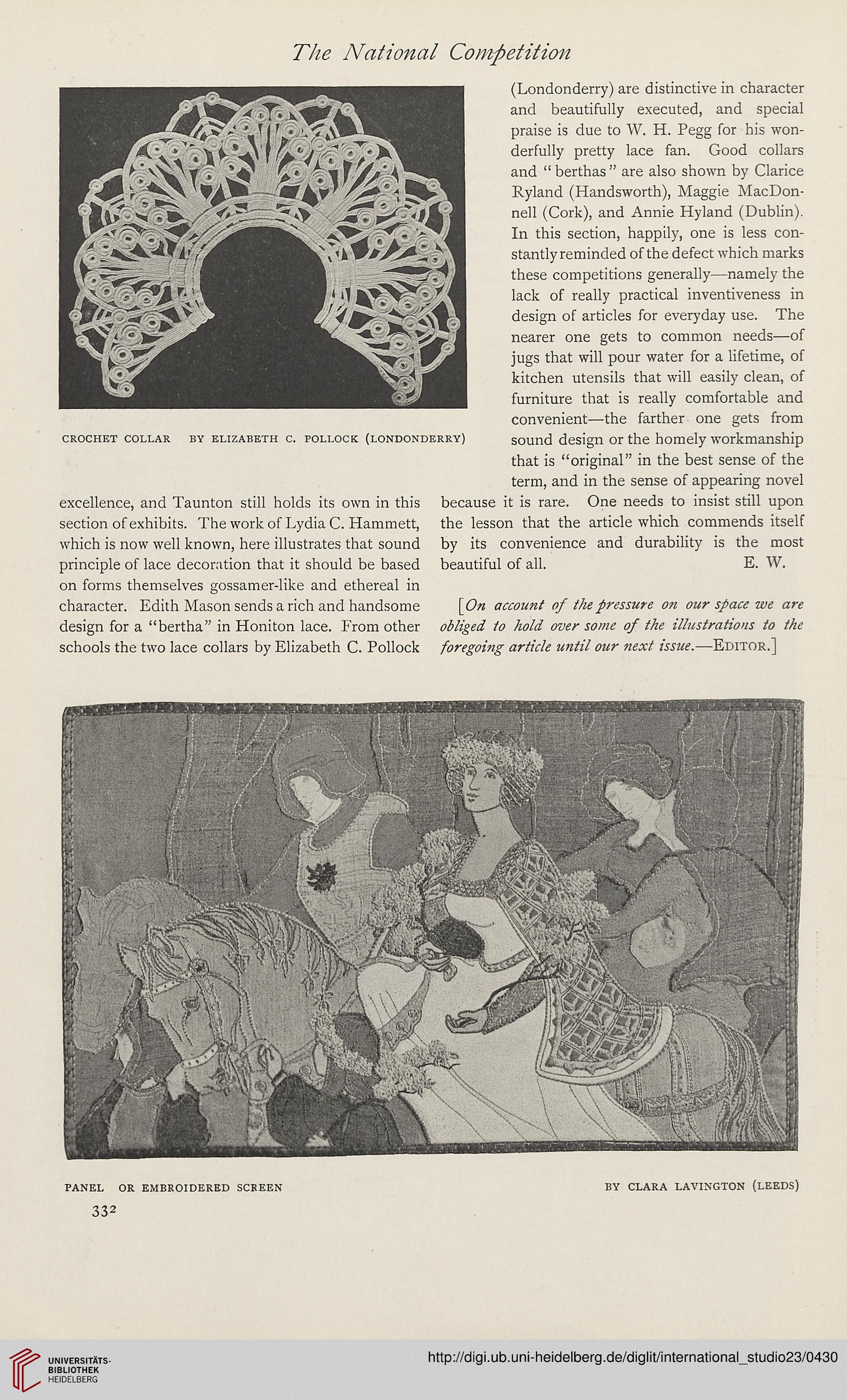The National Competition
excellence, and Taunton still holds its own in this
section of exhibits. The work of Lydia C. Hammett,
which is now well known, here illustrates that sound
principle of lace decoration that it should be based
on forms themselves gossamer-like and ethereal in
character. Edith Mason sends a rich and handsome
design for a “bertha” in Honiton lace. From other
schools the two lace collars by Elizabeth C. Pollock
(Londonderry) are distinctive in character
and beautifully executed, and special
praise is due to W. H. Pegg for his won-
derfully pretty lace fan. Good collars
and “berthas” are also shown by Clarice
Ryland (Handsworth), Maggie MacDon-
nell (Cork), and Annie Hyland (Dublin).
In this section, happily, one is less con-
stantly reminded of the defect which marks
these competitions generally—namely the
lack of really practical inventiveness in
design of articles for everyday use. The
nearer one gets to common needs—of
jugs that will pour water for a lifetime, of
kitchen utensils that will easily clean, of
furniture that is really comfortable and
convenient—the farther one gets from
sound design or the homely workmanship
that is “original” in the best sense of the
term, and in the sense of appearing novel
because it is rare. One needs to insist still upon
the lesson that the article which commends itself
by its convenience and durability is the most
beautiful of all. E. W.
[On account of the pressure on our space we are
obliged to hold over some of the illustrations to the
foregoing article until our next issue.—Editor.]
PANEL OR EMBROIDERED SCREEN
BY CLARA LAVINGTON (LEEDS)
332
excellence, and Taunton still holds its own in this
section of exhibits. The work of Lydia C. Hammett,
which is now well known, here illustrates that sound
principle of lace decoration that it should be based
on forms themselves gossamer-like and ethereal in
character. Edith Mason sends a rich and handsome
design for a “bertha” in Honiton lace. From other
schools the two lace collars by Elizabeth C. Pollock
(Londonderry) are distinctive in character
and beautifully executed, and special
praise is due to W. H. Pegg for his won-
derfully pretty lace fan. Good collars
and “berthas” are also shown by Clarice
Ryland (Handsworth), Maggie MacDon-
nell (Cork), and Annie Hyland (Dublin).
In this section, happily, one is less con-
stantly reminded of the defect which marks
these competitions generally—namely the
lack of really practical inventiveness in
design of articles for everyday use. The
nearer one gets to common needs—of
jugs that will pour water for a lifetime, of
kitchen utensils that will easily clean, of
furniture that is really comfortable and
convenient—the farther one gets from
sound design or the homely workmanship
that is “original” in the best sense of the
term, and in the sense of appearing novel
because it is rare. One needs to insist still upon
the lesson that the article which commends itself
by its convenience and durability is the most
beautiful of all. E. W.
[On account of the pressure on our space we are
obliged to hold over some of the illustrations to the
foregoing article until our next issue.—Editor.]
PANEL OR EMBROIDERED SCREEN
BY CLARA LAVINGTON (LEEDS)
332




